The Samsung Galaxy Note 4 Review
by Joshua Ho on October 15, 2014 9:00 AM EST- Posted in
- Smartphones
- Samsung
- Android
- Mobile
- Galaxy Note 4
Battery Life
Battery life is one of the most important aspects of any mobile device, especially because the battery is what defines mobility to begin with. As a result, it’s important to test battery life in a meaningful manner. This requires a repeatable test with standardized conditions, and a range of scenarios that stress different aspects to get the full picture. Most importantly, for tests that have the display on we calibrate the display to 200 nits to ensure that the test doesn’t penalize brighter displays. In the case of the Galaxy Note 4, we see about a 3% gain in battery capacity, so most of the battery life gains should come from higher efficiency.
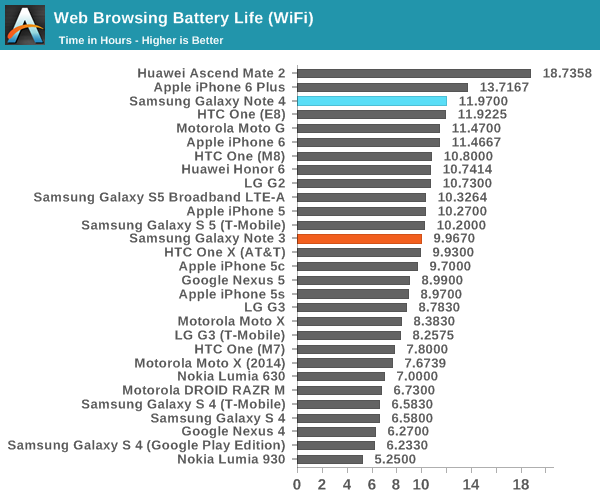
Our first test is the WiFi web browsing test, which loads a given set of web pages in a loop, with special emphasis taken in order to ensure that the test doesn’t penalize faster SoCs, which would have significant effects on our results. As one can see above, the Galaxy Note 4 has a noticeable uplift in battery life when compared to the Galaxy S5 and lasts significantly longer than the Galaxy Note 3. It doesn’t last quite as long as the iPhone 6 Plus, but few people should have issues getting through a full day of intensive use.
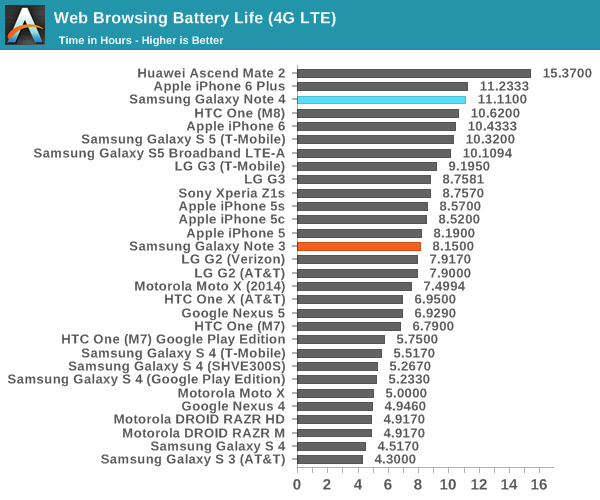
On LTE web browsing, a similar story plays out as the Galaxy Note 4 is able to keep up with the competition and delivers the massive improvement that we’ve generally seen from the transition to Snapdragon 801 and 805.
While the web tests are well-worn by now, we’ve added two additional tests to the battery life suite in order to get a better picture of SoC-bound battery life. To this end, we use an infinite loop of T-Rex on-screen to replicate a GPU-intensive scenario and Basemark OS II’s battery life test to simulate a CPU-intensive scenario.
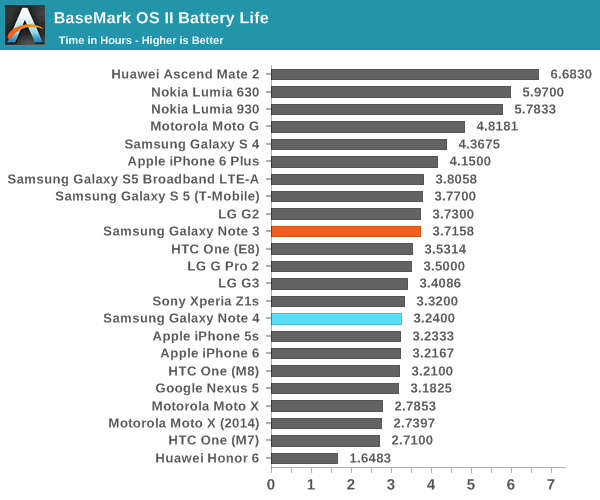
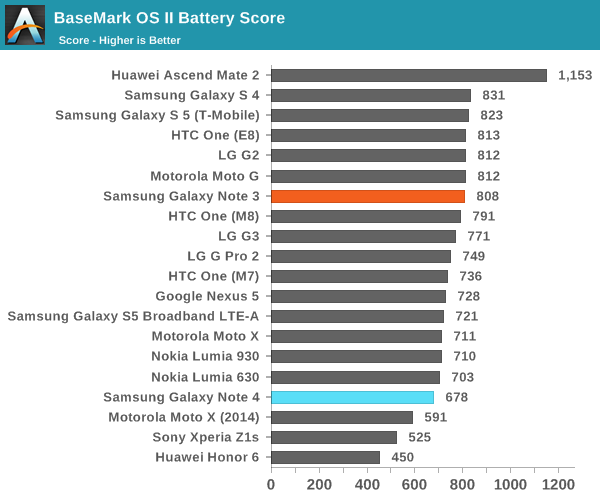
In the case of the Basemark OS II test, we see that battery life under a sustained task ends up a bit lower than we expect, which seems to suggest that in CPU-bound tasks the Note 4 doesn't have much better efficiency when compared to the Galaxy Note 3. This seems to be self-evident, as the CPUs are quite similar and the process technology used is largely similar when comparing the two devices.
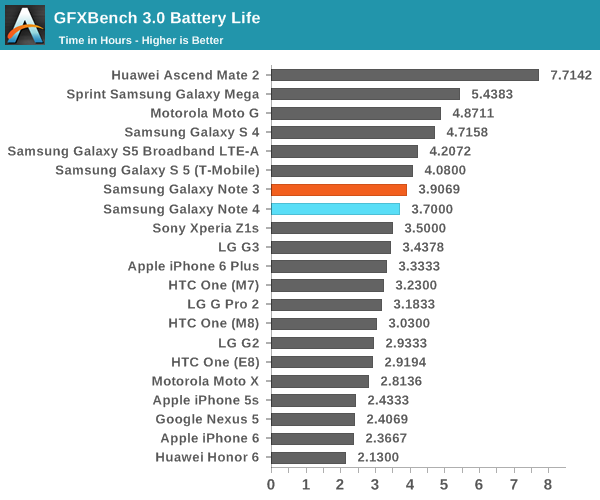
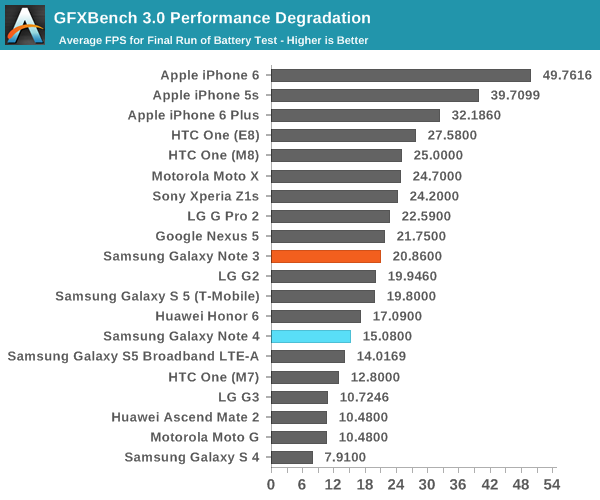
In GFXBench's endless rundown test we see that the Galaxy Note 4 trails behind in battery life when compared to the GS5 LTE-A, but looking at the end of run FPS it’s quite clear that the Galaxy Note 4’s larger surface area makes it possible to achieve greater performance.
Overall, battery life is quite good on the Galaxy Note 4. It’s a massive leap forward when compared to the Galaxy Note 3, but a relatively small one when compared to the Galaxy S5. Once again, we see that most of the benefits in battery life will come from scenarios where power draw isn’t strongly influenced by the display.
Charge Time
As a part of the overall battery life story, it's important to consider the time it takes for a battery to fully charge. If a phone's battery charges slowly then scenarios where charge time becomes crucial will severely hurt real-world battery life. For example, if one forgets to charge their phone at night, the rate at which the phone will charge the battery is a strong influence upon actual battery life. In order to test this, we measure power draw from the time that the device under test is plugged in until it reaches a given level of power draw that indicates that the battery is fully charged.
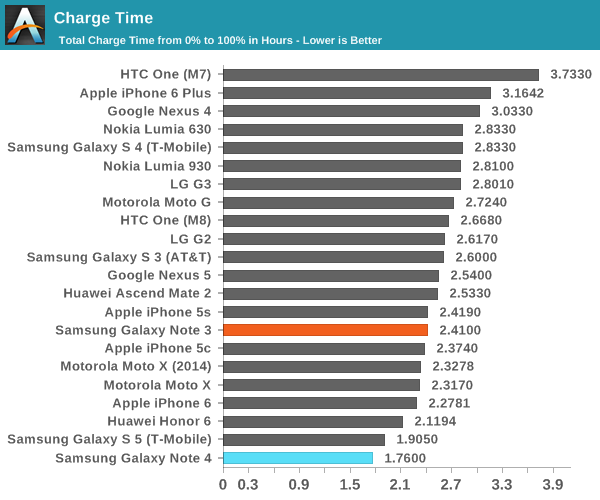
As one can see in the graph above, the adaptive fast-charge mechanism really works, although I don't see a huge benefit when compared to the Galaxy S5's charge time which was already incredibly fast. In the case of the Galaxy Note 4 it seems that it switches between a 9V, 1.64A mode and a 5V, 2A mode as needed, and most of the benefit would come from the first 50% or so of charging as power drops rapidly as the battery approaches full charge.










195 Comments
View All Comments
synaesthetic - Saturday, October 18, 2014 - link
Isn't that the whole point of using Android? I mean, it's kind of a trainwreck when OEM skins and carrier bloatware gets involved. If it wasn't for custom OS flashing I would probably be using a Jolla phone or hanging onto the old Nokia N9. Or just using an iPhone. I mean, if I can't tweak and customize, then my problem with iOS largely disappears.snake2332 - Wednesday, October 22, 2014 - link
That literally is the first thing I do, but I'm not average. However, do average consumers read anandtech? I think not, so there is some relevance to arguing against uhuznaa's statement since a fair amount of people won't be using the stock ROM at all.tralalalalalala40 - Friday, October 17, 2014 - link
So you want him to root the phone to get a proper test. That sounds like an accurate way to model the average consumer use. hasnake2332 - Wednesday, October 22, 2014 - link
Who cares about the average consumer here?seanlumly - Wednesday, October 15, 2014 - link
This review is good, but lacks discussion (or mention, for that matter) about Gear VR, a very significant first-step development in the world of mobile phones. If nothing else, VR may have an effect on the decisions surrounding critical hardware found in future mobiles.theduckofdeath - Wednesday, October 15, 2014 - link
I noticed that too. the Gear VR is actually one the toys I'm looking forward to the most over the next few months.seanlumly - Wednesday, October 15, 2014 - link
Me too! And while I'm looking forward to it, I'm confident that it is a bold and important step for the industry. It potentially adds an alternative to large-screen TVs that have become standard, and open up new ways of sharing information. More importantly, the mobile phone is so ubiquitous that this lowers the cost of VR significantly, and puts it into more hands.Such a thing deserves serious mention in a review of this device as its a serious development.
theuglyman0war - Monday, October 20, 2014 - link
if this is a petition for the interest in the future coverage of vr and phones strapped to my face with rubberbands then count me in pleeeze ( me to )firstever - Wednesday, October 15, 2014 - link
From the brightness tests, the display is 331 nits. How is the readability in the daytime? What does the auto boost do to make the display brighter?theduckofdeath - Wednesday, October 15, 2014 - link
With a contrast ratio of nearly 1,000,000:1 it has a dynamic range in the region of 1000 times better than any LCD display.That gigantic difference means that those miniscule differences in the specs sites like Anandtech always loves to focus on are pretty much irrelevant. I think it was GSM arena who made an visual comparison of outdoor readability on all major brands a few months ago, and even though the GS5 had around half the brightness of the "best" competitors, the GS5 was a lot more readable outdoors.
The adaptive brightness increased the outdoor brightness of something like 100 nits on older Samsung devices, I guess this is in the same region.